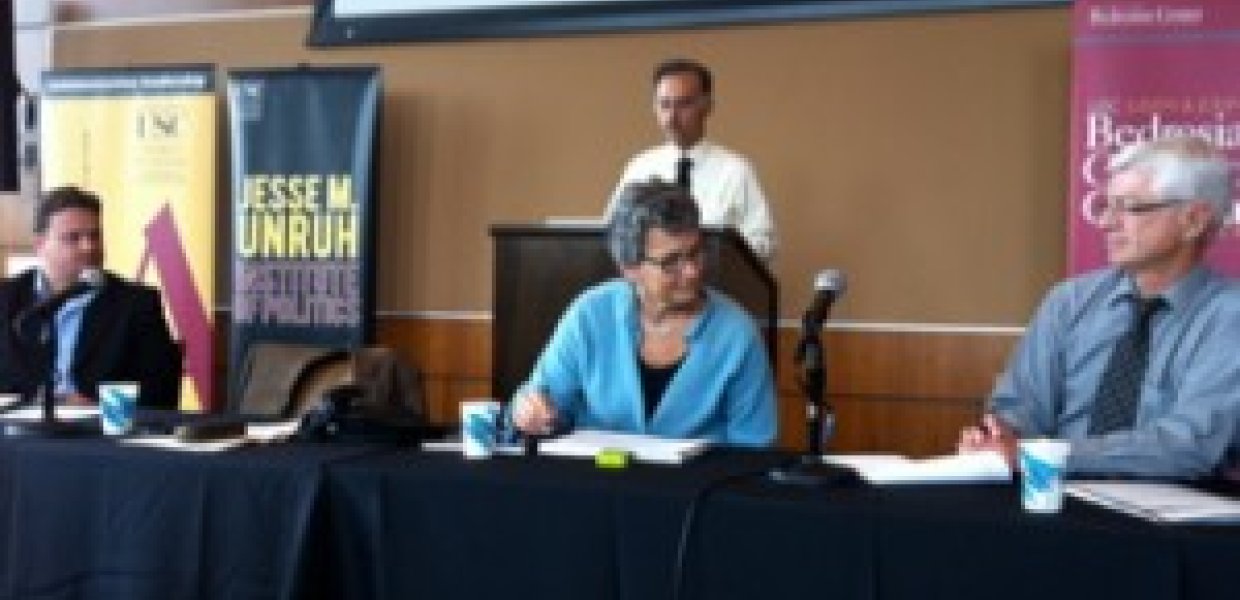 As California climbs towards a projected population of 60 million by 2050, Californians are faced with the challenge of reducing greenhouse gas emissions by 80 percent by 2023. The Oct. 5 "Road to the White House" event, "Is California’s Climate Change Policy the Right Path Forward?", was hosted by Dan Mazmanian, director of USC's Bedrosian Center on Governance and Public Enterprise, and featured Dr. Pom Pom Ganguli, assistant deputy executive officer of the South Coast Air Quality Management District. Ganguli discussed the steps and challenges facing Californians in fulfilling the goals of California's various global warming solutions initiatives. California's green requirements are much more stringent than
As California climbs towards a projected population of 60 million by 2050, Californians are faced with the challenge of reducing greenhouse gas emissions by 80 percent by 2023. The Oct. 5 "Road to the White House" event, "Is California’s Climate Change Policy the Right Path Forward?", was hosted by Dan Mazmanian, director of USC's Bedrosian Center on Governance and Public Enterprise, and featured Dr. Pom Pom Ganguli, assistant deputy executive officer of the South Coast Air Quality Management District. Ganguli discussed the steps and challenges facing Californians in fulfilling the goals of California's various global warming solutions initiatives. California's green requirements are much more stringent than  other clean air standards. The reductions required of some of California's major sectors include: Transportation by 38 percent, Electricity by 23 percent, Industry by 20 percent, commerce and residential by 9 percent and agriculture by 6 percent. All businesses and industries in California need to adhere to these requirements, Mazmanian said. Despite the recession and the costs associated with green technology, 58 percent of Californians voted against the 2010 initiative to defer the implementation of the climate change regulations. "We have made progress despite the spike in population and increase in travel," Ganguli said. "Industries, cars and furnaces have been adapted with cleaner technology." However, the four counties covered by the South Coast Air Quality Management District -- Los Angeles, San Bernardino, Riverside and Orange -- still have the worst air quality in the country. In addition to the threat of global warming, the bad air can lead to respiratory illnesses which are responsible for about 5,000 premature deaths per year, said Ganguli, as well as tremendous amounts of work lost to sick employees. California must reduce overall emissions by 75 – 80 percent by 2023, Ganguli said. "We have federal deadlines in 2023 and 2030 in clean air acts," said Ganguli, "If we dont meet them our transport funds get cut." Fortunately, "Zero emissions technologies appear to be on the horizon," Ganguli said. He discussed soon-to-be-released hydrogen-fuel-cell-powered cars, trucks and buses as well as electric highways that could move goods, trucks and possibility replace locomotives. Ganguli said that the key to fulfilling California's green initiative is to search for collaborative solutions that create synergies between mobility, energy, water, land use, climate and air so that every dollar spent works in each of these agencies together. We cannot depend on government funding alone, so we also need public private partnerships to help finance progress, he said. "If we wait," Ganguli said, "We will pay for it with health and social costs." "Road to the White House" is a series of public conversations jointly presented by USC Annenberg's Center on Communication Leadership & Policy, the USC School of Policy, Planning and Development Bedrosian Center on Governance and Public Enterprise and USC Dornsife College's Unruh Institute of Politics. The sessions take place generally every Wednesday at noon in Tutor Campus Center room 450.
other clean air standards. The reductions required of some of California's major sectors include: Transportation by 38 percent, Electricity by 23 percent, Industry by 20 percent, commerce and residential by 9 percent and agriculture by 6 percent. All businesses and industries in California need to adhere to these requirements, Mazmanian said. Despite the recession and the costs associated with green technology, 58 percent of Californians voted against the 2010 initiative to defer the implementation of the climate change regulations. "We have made progress despite the spike in population and increase in travel," Ganguli said. "Industries, cars and furnaces have been adapted with cleaner technology." However, the four counties covered by the South Coast Air Quality Management District -- Los Angeles, San Bernardino, Riverside and Orange -- still have the worst air quality in the country. In addition to the threat of global warming, the bad air can lead to respiratory illnesses which are responsible for about 5,000 premature deaths per year, said Ganguli, as well as tremendous amounts of work lost to sick employees. California must reduce overall emissions by 75 – 80 percent by 2023, Ganguli said. "We have federal deadlines in 2023 and 2030 in clean air acts," said Ganguli, "If we dont meet them our transport funds get cut." Fortunately, "Zero emissions technologies appear to be on the horizon," Ganguli said. He discussed soon-to-be-released hydrogen-fuel-cell-powered cars, trucks and buses as well as electric highways that could move goods, trucks and possibility replace locomotives. Ganguli said that the key to fulfilling California's green initiative is to search for collaborative solutions that create synergies between mobility, energy, water, land use, climate and air so that every dollar spent works in each of these agencies together. We cannot depend on government funding alone, so we also need public private partnerships to help finance progress, he said. "If we wait," Ganguli said, "We will pay for it with health and social costs." "Road to the White House" is a series of public conversations jointly presented by USC Annenberg's Center on Communication Leadership & Policy, the USC School of Policy, Planning and Development Bedrosian Center on Governance and Public Enterprise and USC Dornsife College's Unruh Institute of Politics. The sessions take place generally every Wednesday at noon in Tutor Campus Center room 450.
Dr. Ganguli talks about California's Climate Change Policy
October 6, 2011
Updated May 1, 2023 11:55 a.m.





